Communication Plan Structure
VerifiedAdded on 2022/09/17
|15
|3286
|18
AI Summary
Contribute Materials
Your contribution can guide someone’s learning journey. Share your
documents today.
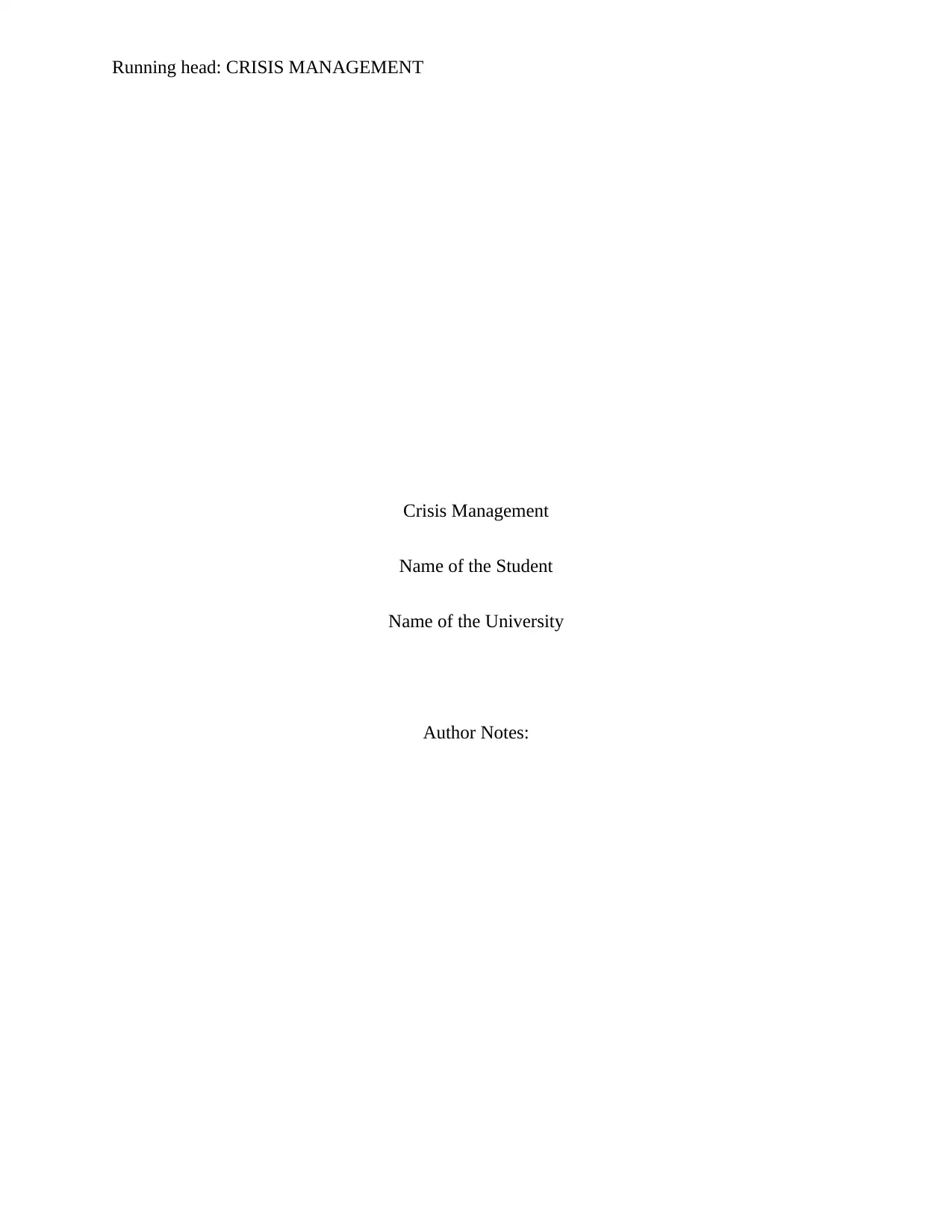
Running head: CRISIS MANAGEMENT
Crisis Management
Name of the Student
Name of the University
Author Notes:
Crisis Management
Name of the Student
Name of the University
Author Notes:
Secure Best Marks with AI Grader
Need help grading? Try our AI Grader for instant feedback on your assignments.
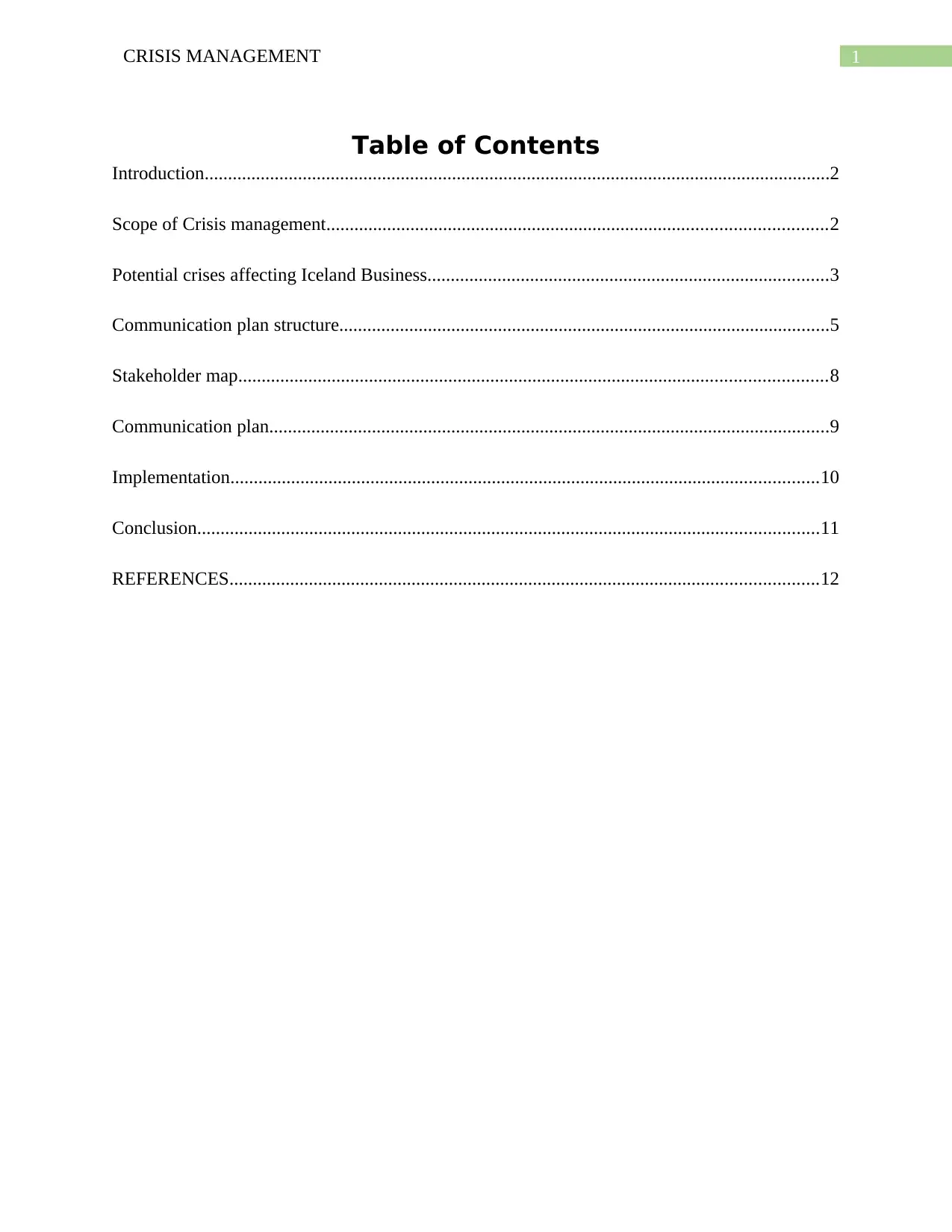
1CRISIS MANAGEMENT
Table of Contents
Introduction......................................................................................................................................2
Scope of Crisis management...........................................................................................................2
Potential crises affecting Iceland Business......................................................................................3
Communication plan structure.........................................................................................................5
Stakeholder map..............................................................................................................................8
Communication plan........................................................................................................................9
Implementation..............................................................................................................................10
Conclusion.....................................................................................................................................11
REFERENCES..............................................................................................................................12
Table of Contents
Introduction......................................................................................................................................2
Scope of Crisis management...........................................................................................................2
Potential crises affecting Iceland Business......................................................................................3
Communication plan structure.........................................................................................................5
Stakeholder map..............................................................................................................................8
Communication plan........................................................................................................................9
Implementation..............................................................................................................................10
Conclusion.....................................................................................................................................11
REFERENCES..............................................................................................................................12
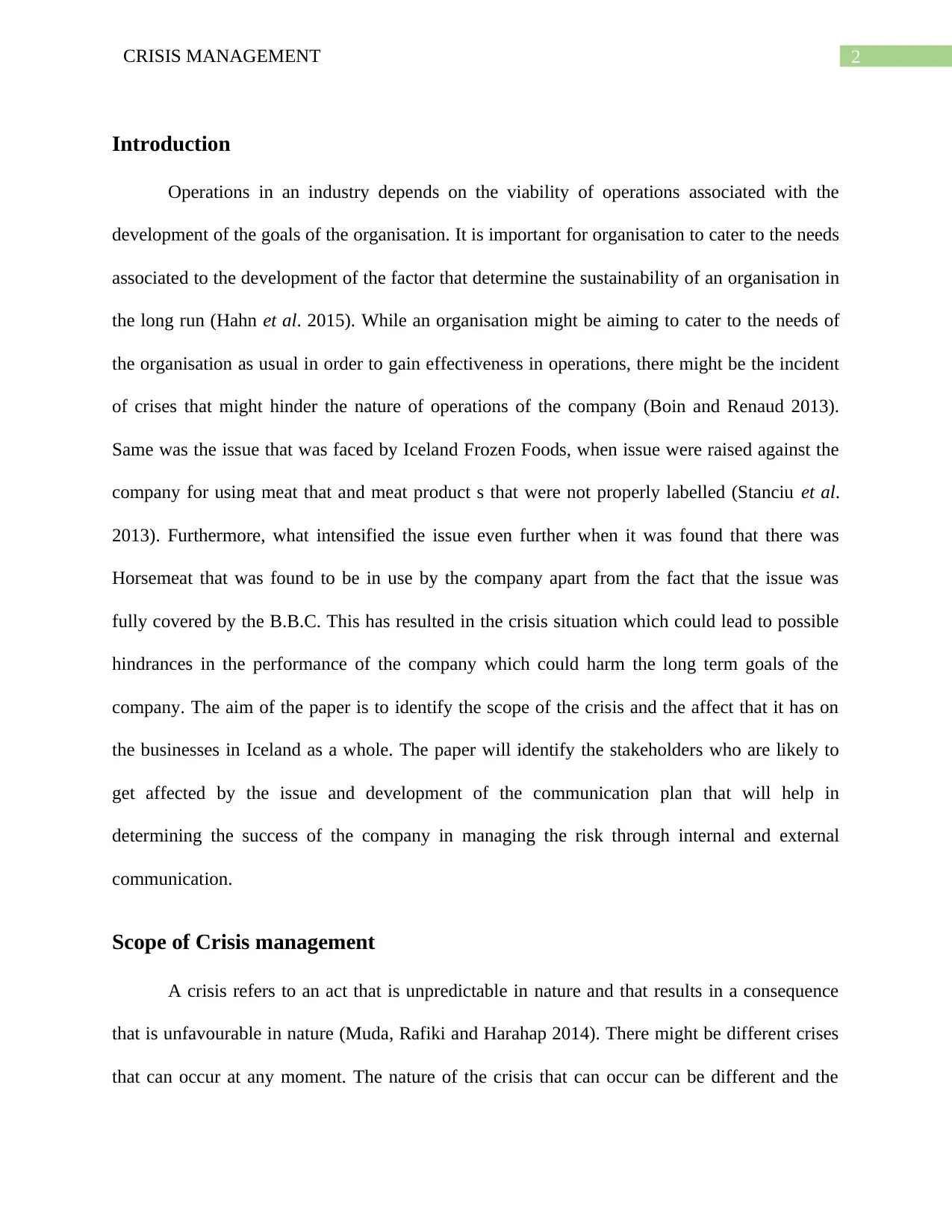
2CRISIS MANAGEMENT
Introduction
Operations in an industry depends on the viability of operations associated with the
development of the goals of the organisation. It is important for organisation to cater to the needs
associated to the development of the factor that determine the sustainability of an organisation in
the long run (Hahn et al. 2015). While an organisation might be aiming to cater to the needs of
the organisation as usual in order to gain effectiveness in operations, there might be the incident
of crises that might hinder the nature of operations of the company (Boin and Renaud 2013).
Same was the issue that was faced by Iceland Frozen Foods, when issue were raised against the
company for using meat that and meat product s that were not properly labelled (Stanciu et al.
2013). Furthermore, what intensified the issue even further when it was found that there was
Horsemeat that was found to be in use by the company apart from the fact that the issue was
fully covered by the B.B.C. This has resulted in the crisis situation which could lead to possible
hindrances in the performance of the company which could harm the long term goals of the
company. The aim of the paper is to identify the scope of the crisis and the affect that it has on
the businesses in Iceland as a whole. The paper will identify the stakeholders who are likely to
get affected by the issue and development of the communication plan that will help in
determining the success of the company in managing the risk through internal and external
communication.
Scope of Crisis management
A crisis refers to an act that is unpredictable in nature and that results in a consequence
that is unfavourable in nature (Muda, Rafiki and Harahap 2014). There might be different crises
that can occur at any moment. The nature of the crisis that can occur can be different and the
Introduction
Operations in an industry depends on the viability of operations associated with the
development of the goals of the organisation. It is important for organisation to cater to the needs
associated to the development of the factor that determine the sustainability of an organisation in
the long run (Hahn et al. 2015). While an organisation might be aiming to cater to the needs of
the organisation as usual in order to gain effectiveness in operations, there might be the incident
of crises that might hinder the nature of operations of the company (Boin and Renaud 2013).
Same was the issue that was faced by Iceland Frozen Foods, when issue were raised against the
company for using meat that and meat product s that were not properly labelled (Stanciu et al.
2013). Furthermore, what intensified the issue even further when it was found that there was
Horsemeat that was found to be in use by the company apart from the fact that the issue was
fully covered by the B.B.C. This has resulted in the crisis situation which could lead to possible
hindrances in the performance of the company which could harm the long term goals of the
company. The aim of the paper is to identify the scope of the crisis and the affect that it has on
the businesses in Iceland as a whole. The paper will identify the stakeholders who are likely to
get affected by the issue and development of the communication plan that will help in
determining the success of the company in managing the risk through internal and external
communication.
Scope of Crisis management
A crisis refers to an act that is unpredictable in nature and that results in a consequence
that is unfavourable in nature (Muda, Rafiki and Harahap 2014). There might be different crises
that can occur at any moment. The nature of the crisis that can occur can be different and the
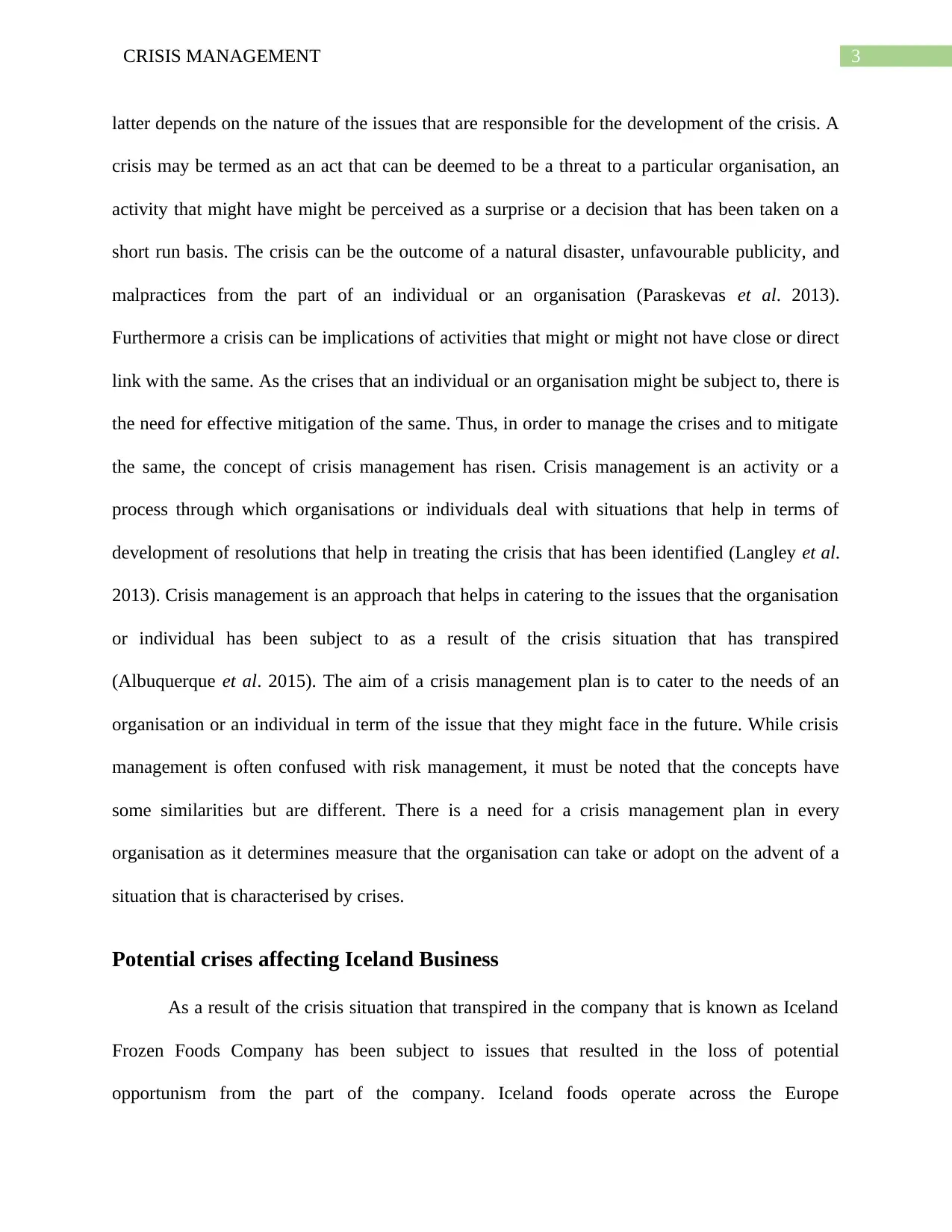
3CRISIS MANAGEMENT
latter depends on the nature of the issues that are responsible for the development of the crisis. A
crisis may be termed as an act that can be deemed to be a threat to a particular organisation, an
activity that might have might be perceived as a surprise or a decision that has been taken on a
short run basis. The crisis can be the outcome of a natural disaster, unfavourable publicity, and
malpractices from the part of an individual or an organisation (Paraskevas et al. 2013).
Furthermore a crisis can be implications of activities that might or might not have close or direct
link with the same. As the crises that an individual or an organisation might be subject to, there is
the need for effective mitigation of the same. Thus, in order to manage the crises and to mitigate
the same, the concept of crisis management has risen. Crisis management is an activity or a
process through which organisations or individuals deal with situations that help in terms of
development of resolutions that help in treating the crisis that has been identified (Langley et al.
2013). Crisis management is an approach that helps in catering to the issues that the organisation
or individual has been subject to as a result of the crisis situation that has transpired
(Albuquerque et al. 2015). The aim of a crisis management plan is to cater to the needs of an
organisation or an individual in term of the issue that they might face in the future. While crisis
management is often confused with risk management, it must be noted that the concepts have
some similarities but are different. There is a need for a crisis management plan in every
organisation as it determines measure that the organisation can take or adopt on the advent of a
situation that is characterised by crises.
Potential crises affecting Iceland Business
As a result of the crisis situation that transpired in the company that is known as Iceland
Frozen Foods Company has been subject to issues that resulted in the loss of potential
opportunism from the part of the company. Iceland foods operate across the Europe
latter depends on the nature of the issues that are responsible for the development of the crisis. A
crisis may be termed as an act that can be deemed to be a threat to a particular organisation, an
activity that might have might be perceived as a surprise or a decision that has been taken on a
short run basis. The crisis can be the outcome of a natural disaster, unfavourable publicity, and
malpractices from the part of an individual or an organisation (Paraskevas et al. 2013).
Furthermore a crisis can be implications of activities that might or might not have close or direct
link with the same. As the crises that an individual or an organisation might be subject to, there is
the need for effective mitigation of the same. Thus, in order to manage the crises and to mitigate
the same, the concept of crisis management has risen. Crisis management is an activity or a
process through which organisations or individuals deal with situations that help in terms of
development of resolutions that help in treating the crisis that has been identified (Langley et al.
2013). Crisis management is an approach that helps in catering to the issues that the organisation
or individual has been subject to as a result of the crisis situation that has transpired
(Albuquerque et al. 2015). The aim of a crisis management plan is to cater to the needs of an
organisation or an individual in term of the issue that they might face in the future. While crisis
management is often confused with risk management, it must be noted that the concepts have
some similarities but are different. There is a need for a crisis management plan in every
organisation as it determines measure that the organisation can take or adopt on the advent of a
situation that is characterised by crises.
Potential crises affecting Iceland Business
As a result of the crisis situation that transpired in the company that is known as Iceland
Frozen Foods Company has been subject to issues that resulted in the loss of potential
opportunism from the part of the company. Iceland foods operate across the Europe
Paraphrase This Document
Need a fresh take? Get an instant paraphrase of this document with our AI Paraphraser
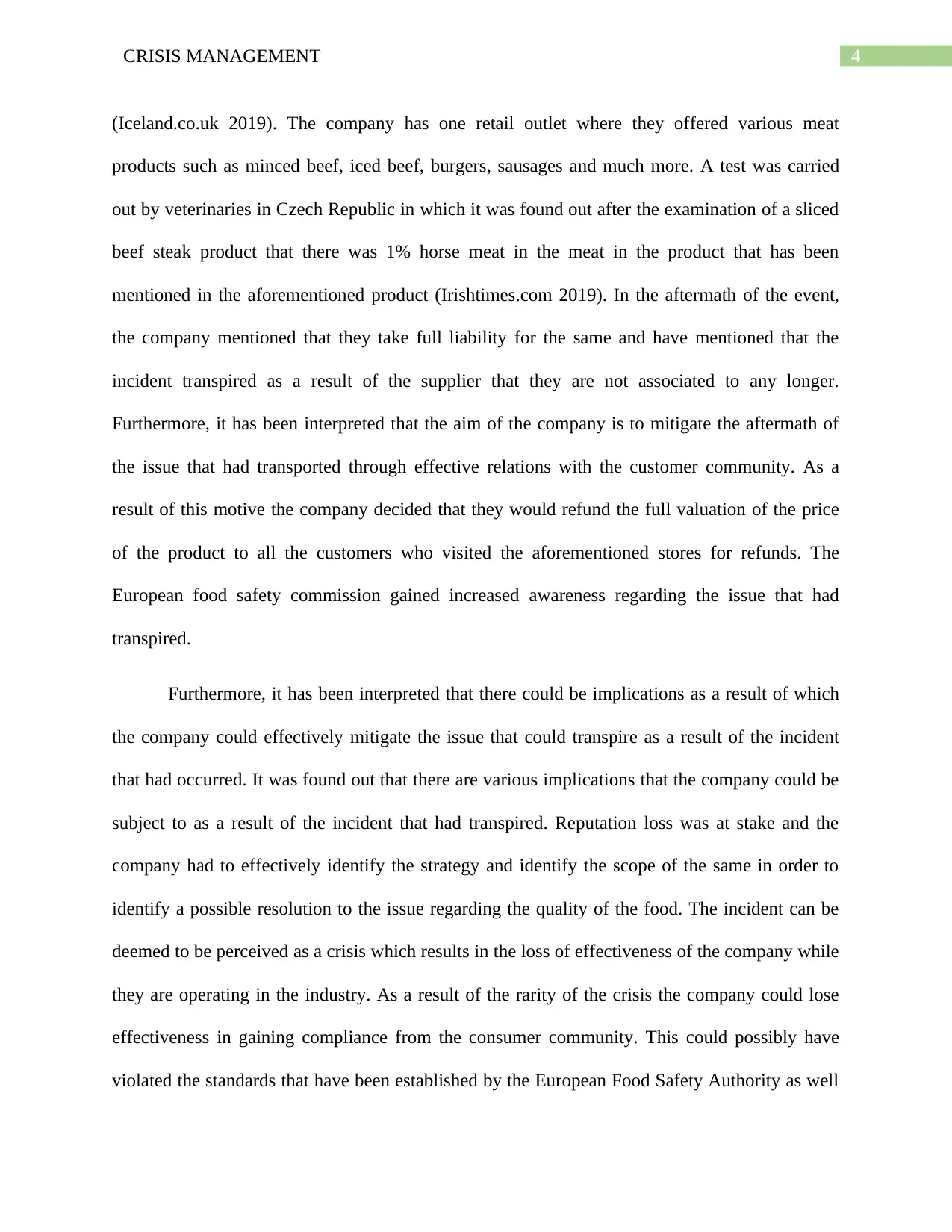
4CRISIS MANAGEMENT
(Iceland.co.uk 2019). The company has one retail outlet where they offered various meat
products such as minced beef, iced beef, burgers, sausages and much more. A test was carried
out by veterinaries in Czech Republic in which it was found out after the examination of a sliced
beef steak product that there was 1% horse meat in the meat in the product that has been
mentioned in the aforementioned product (Irishtimes.com 2019). In the aftermath of the event,
the company mentioned that they take full liability for the same and have mentioned that the
incident transpired as a result of the supplier that they are not associated to any longer.
Furthermore, it has been interpreted that the aim of the company is to mitigate the aftermath of
the issue that had transported through effective relations with the customer community. As a
result of this motive the company decided that they would refund the full valuation of the price
of the product to all the customers who visited the aforementioned stores for refunds. The
European food safety commission gained increased awareness regarding the issue that had
transpired.
Furthermore, it has been interpreted that there could be implications as a result of which
the company could effectively mitigate the issue that could transpire as a result of the incident
that had occurred. It was found out that there are various implications that the company could be
subject to as a result of the incident that had transpired. Reputation loss was at stake and the
company had to effectively identify the strategy and identify the scope of the same in order to
identify a possible resolution to the issue regarding the quality of the food. The incident can be
deemed to be perceived as a crisis which results in the loss of effectiveness of the company while
they are operating in the industry. As a result of the rarity of the crisis the company could lose
effectiveness in gaining compliance from the consumer community. This could possibly have
violated the standards that have been established by the European Food Safety Authority as well
(Iceland.co.uk 2019). The company has one retail outlet where they offered various meat
products such as minced beef, iced beef, burgers, sausages and much more. A test was carried
out by veterinaries in Czech Republic in which it was found out after the examination of a sliced
beef steak product that there was 1% horse meat in the meat in the product that has been
mentioned in the aforementioned product (Irishtimes.com 2019). In the aftermath of the event,
the company mentioned that they take full liability for the same and have mentioned that the
incident transpired as a result of the supplier that they are not associated to any longer.
Furthermore, it has been interpreted that the aim of the company is to mitigate the aftermath of
the issue that had transported through effective relations with the customer community. As a
result of this motive the company decided that they would refund the full valuation of the price
of the product to all the customers who visited the aforementioned stores for refunds. The
European food safety commission gained increased awareness regarding the issue that had
transpired.
Furthermore, it has been interpreted that there could be implications as a result of which
the company could effectively mitigate the issue that could transpire as a result of the incident
that had occurred. It was found out that there are various implications that the company could be
subject to as a result of the incident that had transpired. Reputation loss was at stake and the
company had to effectively identify the strategy and identify the scope of the same in order to
identify a possible resolution to the issue regarding the quality of the food. The incident can be
deemed to be perceived as a crisis which results in the loss of effectiveness of the company while
they are operating in the industry. As a result of the rarity of the crisis the company could lose
effectiveness in gaining compliance from the consumer community. This could possibly have
violated the standards that have been established by the European Food Safety Authority as well
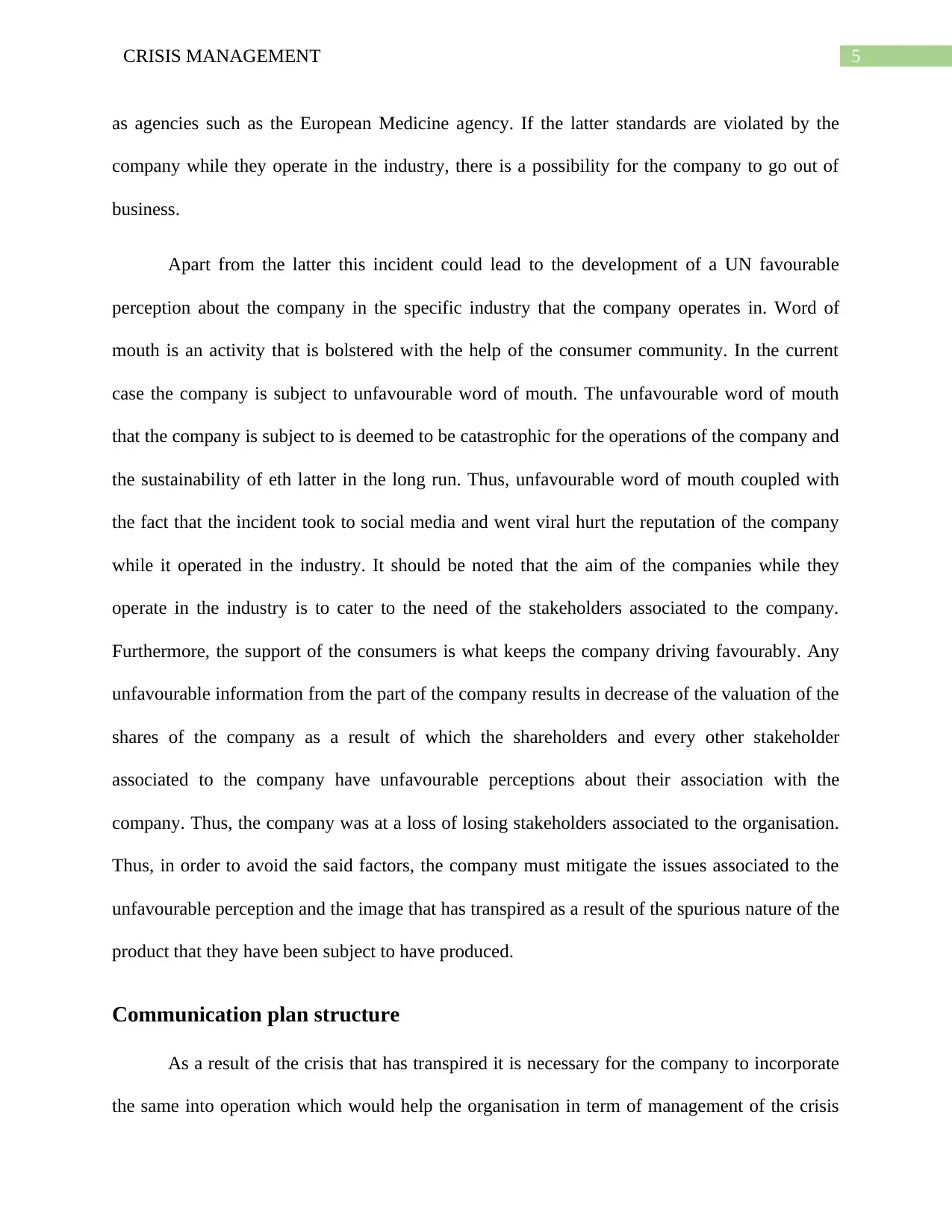
5CRISIS MANAGEMENT
as agencies such as the European Medicine agency. If the latter standards are violated by the
company while they operate in the industry, there is a possibility for the company to go out of
business.
Apart from the latter this incident could lead to the development of a UN favourable
perception about the company in the specific industry that the company operates in. Word of
mouth is an activity that is bolstered with the help of the consumer community. In the current
case the company is subject to unfavourable word of mouth. The unfavourable word of mouth
that the company is subject to is deemed to be catastrophic for the operations of the company and
the sustainability of eth latter in the long run. Thus, unfavourable word of mouth coupled with
the fact that the incident took to social media and went viral hurt the reputation of the company
while it operated in the industry. It should be noted that the aim of the companies while they
operate in the industry is to cater to the need of the stakeholders associated to the company.
Furthermore, the support of the consumers is what keeps the company driving favourably. Any
unfavourable information from the part of the company results in decrease of the valuation of the
shares of the company as a result of which the shareholders and every other stakeholder
associated to the company have unfavourable perceptions about their association with the
company. Thus, the company was at a loss of losing stakeholders associated to the organisation.
Thus, in order to avoid the said factors, the company must mitigate the issues associated to the
unfavourable perception and the image that has transpired as a result of the spurious nature of the
product that they have been subject to have produced.
Communication plan structure
As a result of the crisis that has transpired it is necessary for the company to incorporate
the same into operation which would help the organisation in term of management of the crisis
as agencies such as the European Medicine agency. If the latter standards are violated by the
company while they operate in the industry, there is a possibility for the company to go out of
business.
Apart from the latter this incident could lead to the development of a UN favourable
perception about the company in the specific industry that the company operates in. Word of
mouth is an activity that is bolstered with the help of the consumer community. In the current
case the company is subject to unfavourable word of mouth. The unfavourable word of mouth
that the company is subject to is deemed to be catastrophic for the operations of the company and
the sustainability of eth latter in the long run. Thus, unfavourable word of mouth coupled with
the fact that the incident took to social media and went viral hurt the reputation of the company
while it operated in the industry. It should be noted that the aim of the companies while they
operate in the industry is to cater to the need of the stakeholders associated to the company.
Furthermore, the support of the consumers is what keeps the company driving favourably. Any
unfavourable information from the part of the company results in decrease of the valuation of the
shares of the company as a result of which the shareholders and every other stakeholder
associated to the company have unfavourable perceptions about their association with the
company. Thus, the company was at a loss of losing stakeholders associated to the organisation.
Thus, in order to avoid the said factors, the company must mitigate the issues associated to the
unfavourable perception and the image that has transpired as a result of the spurious nature of the
product that they have been subject to have produced.
Communication plan structure
As a result of the crisis that has transpired it is necessary for the company to incorporate
the same into operation which would help the organisation in term of management of the crisis
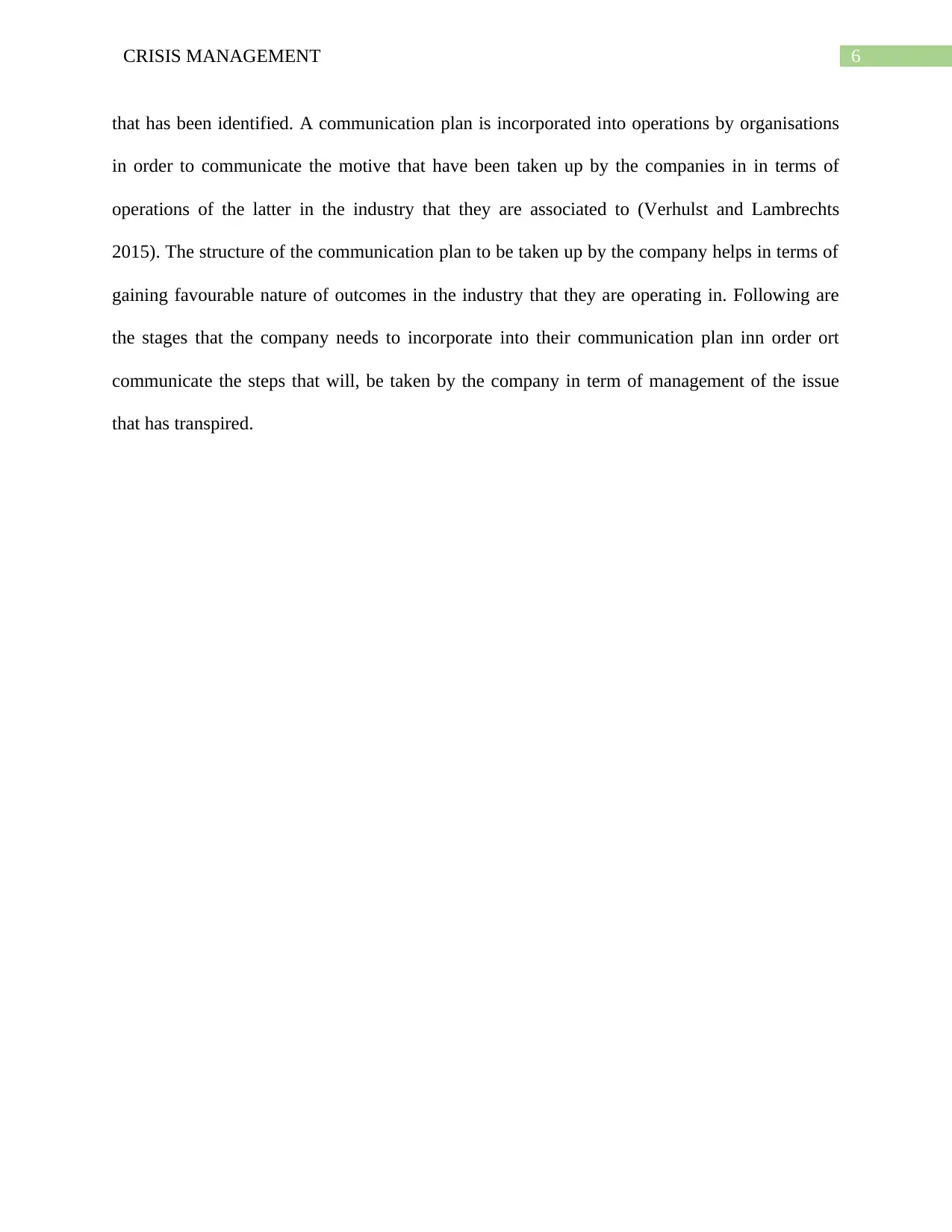
6CRISIS MANAGEMENT
that has been identified. A communication plan is incorporated into operations by organisations
in order to communicate the motive that have been taken up by the companies in in terms of
operations of the latter in the industry that they are associated to (Verhulst and Lambrechts
2015). The structure of the communication plan to be taken up by the company helps in terms of
gaining favourable nature of outcomes in the industry that they are operating in. Following are
the stages that the company needs to incorporate into their communication plan inn order ort
communicate the steps that will, be taken by the company in term of management of the issue
that has transpired.
that has been identified. A communication plan is incorporated into operations by organisations
in order to communicate the motive that have been taken up by the companies in in terms of
operations of the latter in the industry that they are associated to (Verhulst and Lambrechts
2015). The structure of the communication plan to be taken up by the company helps in terms of
gaining favourable nature of outcomes in the industry that they are operating in. Following are
the stages that the company needs to incorporate into their communication plan inn order ort
communicate the steps that will, be taken by the company in term of management of the issue
that has transpired.
Secure Best Marks with AI Grader
Need help grading? Try our AI Grader for instant feedback on your assignments.
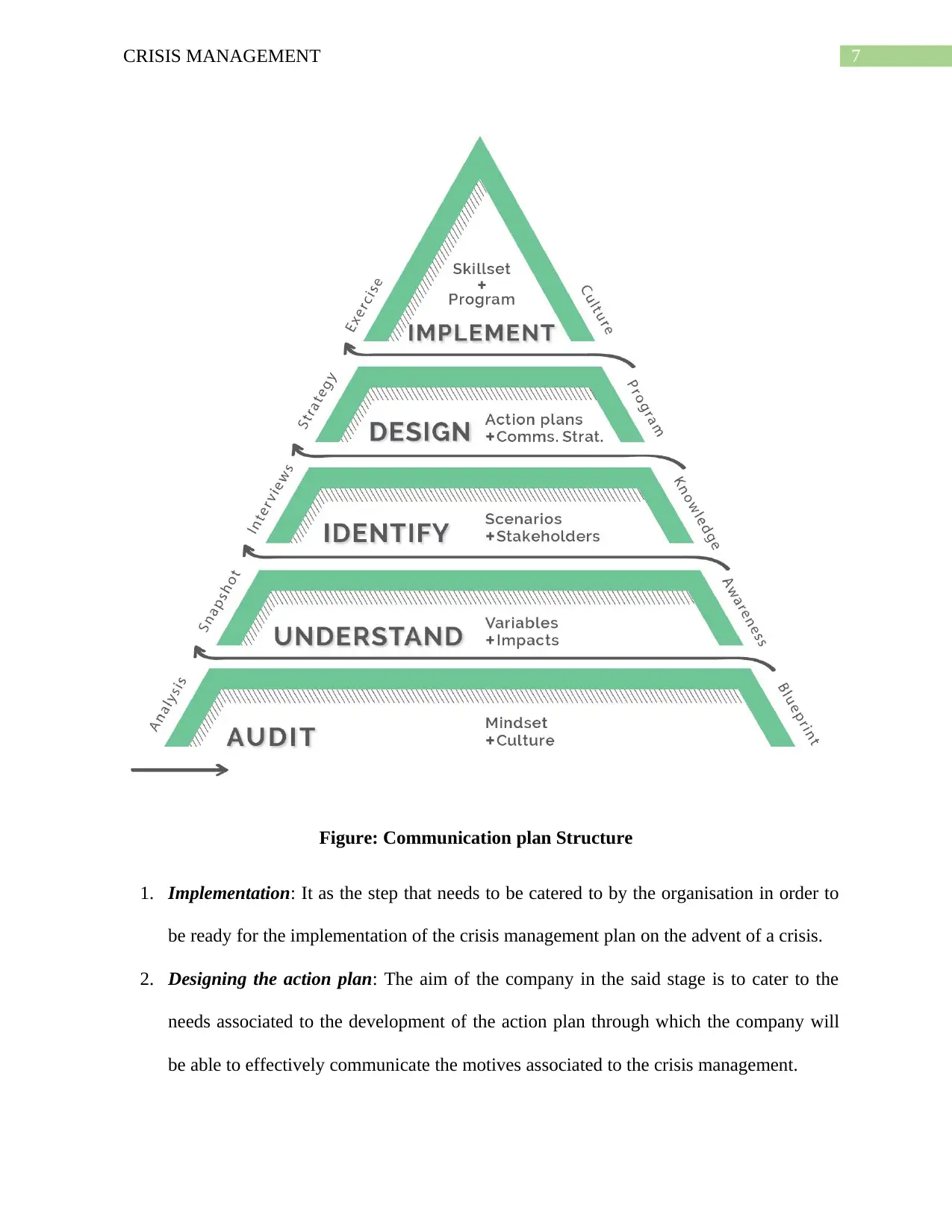
7CRISIS MANAGEMENT
Figure: Communication plan Structure
1. Implementation: It as the step that needs to be catered to by the organisation in order to
be ready for the implementation of the crisis management plan on the advent of a crisis.
2. Designing the action plan: The aim of the company in the said stage is to cater to the
needs associated to the development of the action plan through which the company will
be able to effectively communicate the motives associated to the crisis management.
Figure: Communication plan Structure
1. Implementation: It as the step that needs to be catered to by the organisation in order to
be ready for the implementation of the crisis management plan on the advent of a crisis.
2. Designing the action plan: The aim of the company in the said stage is to cater to the
needs associated to the development of the action plan through which the company will
be able to effectively communicate the motives associated to the crisis management.
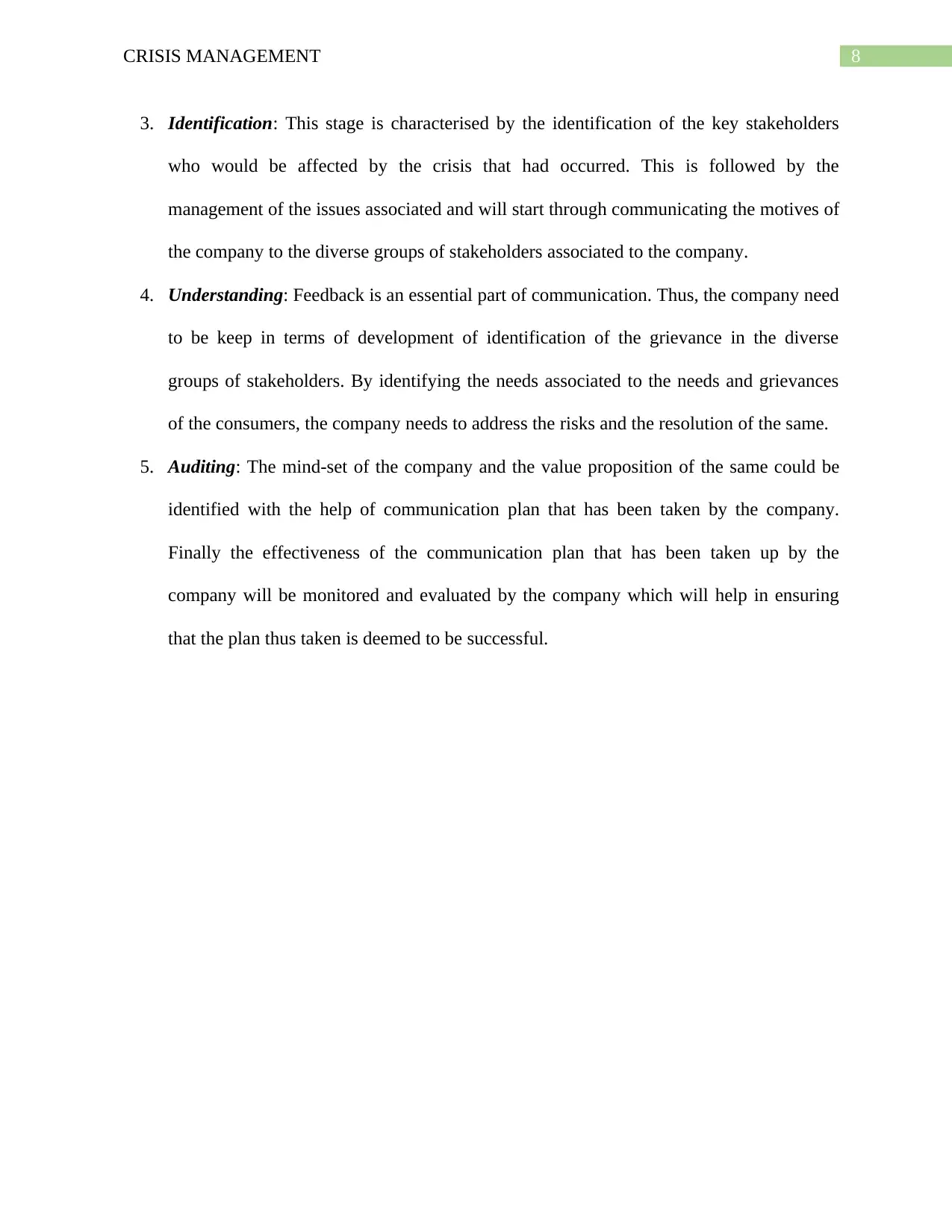
8CRISIS MANAGEMENT
3. Identification: This stage is characterised by the identification of the key stakeholders
who would be affected by the crisis that had occurred. This is followed by the
management of the issues associated and will start through communicating the motives of
the company to the diverse groups of stakeholders associated to the company.
4. Understanding: Feedback is an essential part of communication. Thus, the company need
to be keep in terms of development of identification of the grievance in the diverse
groups of stakeholders. By identifying the needs associated to the needs and grievances
of the consumers, the company needs to address the risks and the resolution of the same.
5. Auditing: The mind-set of the company and the value proposition of the same could be
identified with the help of communication plan that has been taken by the company.
Finally the effectiveness of the communication plan that has been taken up by the
company will be monitored and evaluated by the company which will help in ensuring
that the plan thus taken is deemed to be successful.
3. Identification: This stage is characterised by the identification of the key stakeholders
who would be affected by the crisis that had occurred. This is followed by the
management of the issues associated and will start through communicating the motives of
the company to the diverse groups of stakeholders associated to the company.
4. Understanding: Feedback is an essential part of communication. Thus, the company need
to be keep in terms of development of identification of the grievance in the diverse
groups of stakeholders. By identifying the needs associated to the needs and grievances
of the consumers, the company needs to address the risks and the resolution of the same.
5. Auditing: The mind-set of the company and the value proposition of the same could be
identified with the help of communication plan that has been taken by the company.
Finally the effectiveness of the communication plan that has been taken up by the
company will be monitored and evaluated by the company which will help in ensuring
that the plan thus taken is deemed to be successful.
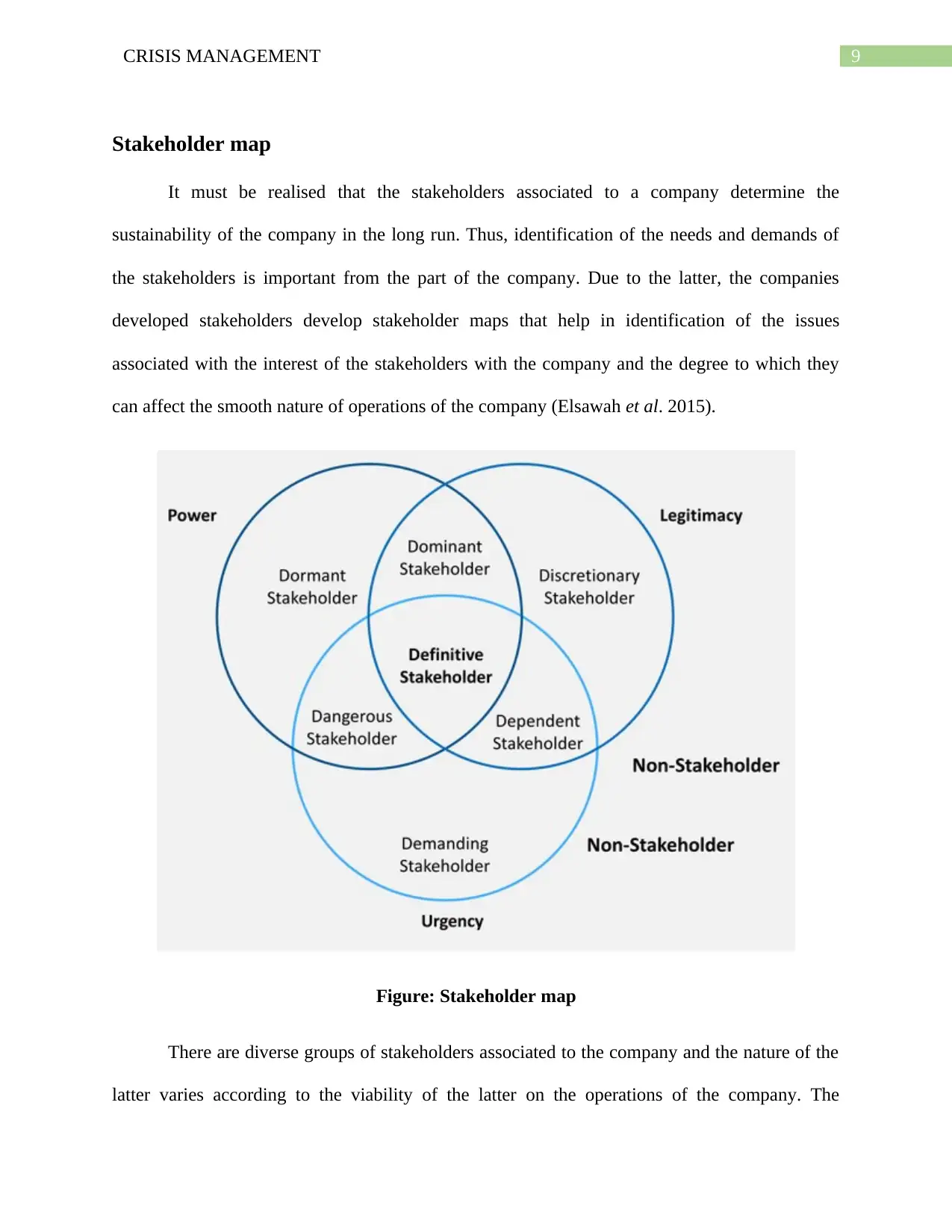
9CRISIS MANAGEMENT
Stakeholder map
It must be realised that the stakeholders associated to a company determine the
sustainability of the company in the long run. Thus, identification of the needs and demands of
the stakeholders is important from the part of the company. Due to the latter, the companies
developed stakeholders develop stakeholder maps that help in identification of the issues
associated with the interest of the stakeholders with the company and the degree to which they
can affect the smooth nature of operations of the company (Elsawah et al. 2015).
Figure: Stakeholder map
There are diverse groups of stakeholders associated to the company and the nature of the
latter varies according to the viability of the latter on the operations of the company. The
Stakeholder map
It must be realised that the stakeholders associated to a company determine the
sustainability of the company in the long run. Thus, identification of the needs and demands of
the stakeholders is important from the part of the company. Due to the latter, the companies
developed stakeholders develop stakeholder maps that help in identification of the issues
associated with the interest of the stakeholders with the company and the degree to which they
can affect the smooth nature of operations of the company (Elsawah et al. 2015).
Figure: Stakeholder map
There are diverse groups of stakeholders associated to the company and the nature of the
latter varies according to the viability of the latter on the operations of the company. The
Paraphrase This Document
Need a fresh take? Get an instant paraphrase of this document with our AI Paraphraser

10CRISIS MANAGEMENT
dormant, dominant, and discretionary stakeholders are the regulatory bodies, the board of
directors and the discretionary stakeholder associated to the company is the management of the
company, the media and the community. The definitive stakeholders are the most important
stakeholders who affect the viability of operations of the company both in the short and the long
run. The customers, the prospective or the potential consumers are the definitive stakeholders.
The media and the consumers can be termed as the dangerous stakeholders, the employees are
the dependent stakeholders and finally the demanding stakeholders is the government, the
environment and the regulatory bodies.
Communication plan
The communication plan that is to be taken by the company while they are operating in
the industry aiming to mitigate the differences that resulted due to the horse meat controversy
(Kim and Dear, 2013). The aim of the communication plan is to communicate the steps to be
taken by the company and the response of the company for the detected situation of crisis. The
internal stakeholders are to be informed as the latter would determine the viability of operations
of the company while they are operating in the in terms of management of the crisis. Every level
of the management of the company and the employees have to be informed regarding the
situation and the objectives that have been implemented by the company in terms of
development of a rationale that helps the company in terms of achievement of the ultimate goal
that is management of the crisis. It is important to communicate the motives of a company to the
internal stakeholders of the company as they determine the viability of achievement of the said
objectives of the company. Furthermore, communication helps in notifying the latter about their
role which would help the employees of the company in terms of achievement of their personal
dormant, dominant, and discretionary stakeholders are the regulatory bodies, the board of
directors and the discretionary stakeholder associated to the company is the management of the
company, the media and the community. The definitive stakeholders are the most important
stakeholders who affect the viability of operations of the company both in the short and the long
run. The customers, the prospective or the potential consumers are the definitive stakeholders.
The media and the consumers can be termed as the dangerous stakeholders, the employees are
the dependent stakeholders and finally the demanding stakeholders is the government, the
environment and the regulatory bodies.
Communication plan
The communication plan that is to be taken by the company while they are operating in
the industry aiming to mitigate the differences that resulted due to the horse meat controversy
(Kim and Dear, 2013). The aim of the communication plan is to communicate the steps to be
taken by the company and the response of the company for the detected situation of crisis. The
internal stakeholders are to be informed as the latter would determine the viability of operations
of the company while they are operating in the in terms of management of the crisis. Every level
of the management of the company and the employees have to be informed regarding the
situation and the objectives that have been implemented by the company in terms of
development of a rationale that helps the company in terms of achievement of the ultimate goal
that is management of the crisis. It is important to communicate the motives of a company to the
internal stakeholders of the company as they determine the viability of achievement of the said
objectives of the company. Furthermore, communication helps in notifying the latter about their
role which would help the employees of the company in terms of achievement of their personal
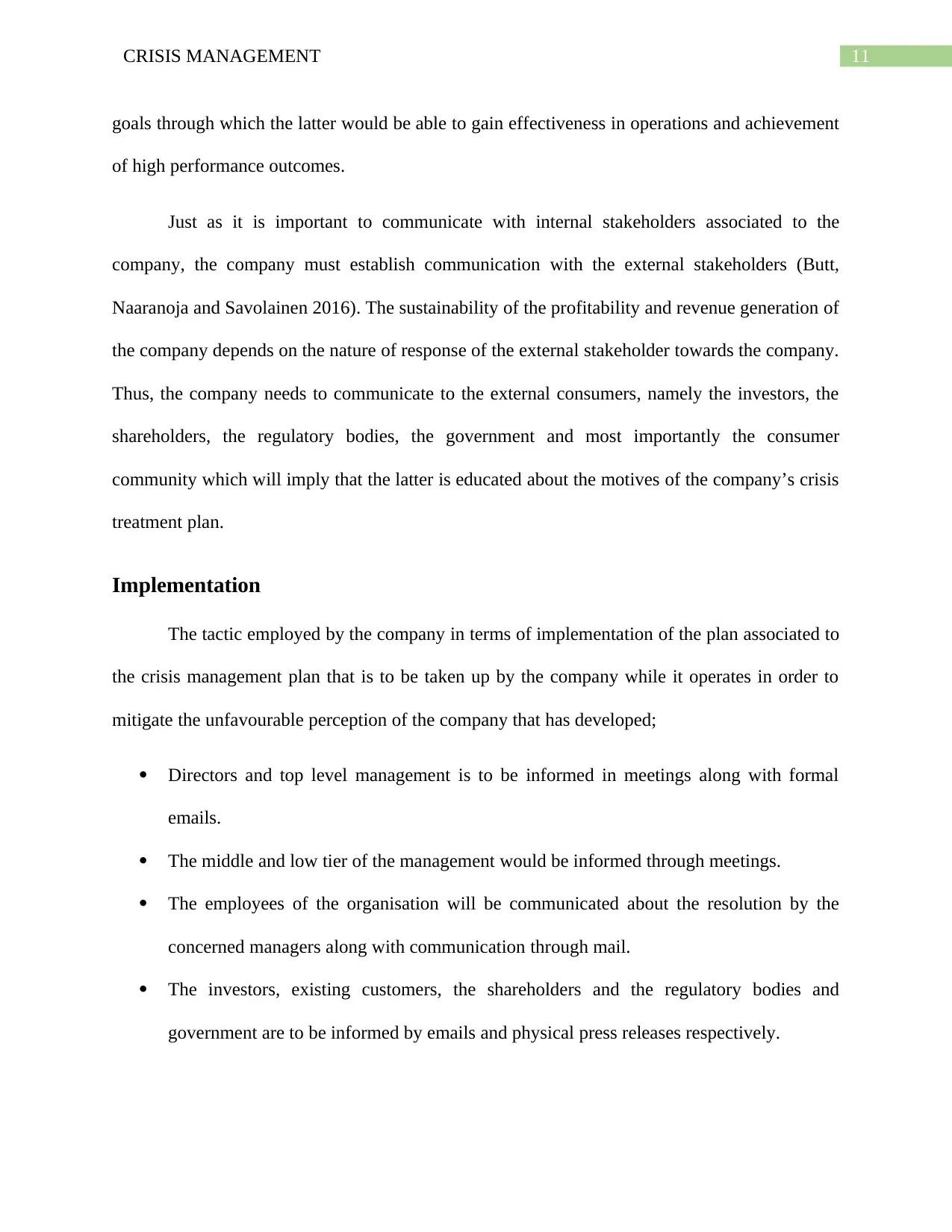
11CRISIS MANAGEMENT
goals through which the latter would be able to gain effectiveness in operations and achievement
of high performance outcomes.
Just as it is important to communicate with internal stakeholders associated to the
company, the company must establish communication with the external stakeholders (Butt,
Naaranoja and Savolainen 2016). The sustainability of the profitability and revenue generation of
the company depends on the nature of response of the external stakeholder towards the company.
Thus, the company needs to communicate to the external consumers, namely the investors, the
shareholders, the regulatory bodies, the government and most importantly the consumer
community which will imply that the latter is educated about the motives of the company’s crisis
treatment plan.
Implementation
The tactic employed by the company in terms of implementation of the plan associated to
the crisis management plan that is to be taken up by the company while it operates in order to
mitigate the unfavourable perception of the company that has developed;
Directors and top level management is to be informed in meetings along with formal
emails.
The middle and low tier of the management would be informed through meetings.
The employees of the organisation will be communicated about the resolution by the
concerned managers along with communication through mail.
The investors, existing customers, the shareholders and the regulatory bodies and
government are to be informed by emails and physical press releases respectively.
goals through which the latter would be able to gain effectiveness in operations and achievement
of high performance outcomes.
Just as it is important to communicate with internal stakeholders associated to the
company, the company must establish communication with the external stakeholders (Butt,
Naaranoja and Savolainen 2016). The sustainability of the profitability and revenue generation of
the company depends on the nature of response of the external stakeholder towards the company.
Thus, the company needs to communicate to the external consumers, namely the investors, the
shareholders, the regulatory bodies, the government and most importantly the consumer
community which will imply that the latter is educated about the motives of the company’s crisis
treatment plan.
Implementation
The tactic employed by the company in terms of implementation of the plan associated to
the crisis management plan that is to be taken up by the company while it operates in order to
mitigate the unfavourable perception of the company that has developed;
Directors and top level management is to be informed in meetings along with formal
emails.
The middle and low tier of the management would be informed through meetings.
The employees of the organisation will be communicated about the resolution by the
concerned managers along with communication through mail.
The investors, existing customers, the shareholders and the regulatory bodies and
government are to be informed by emails and physical press releases respectively.
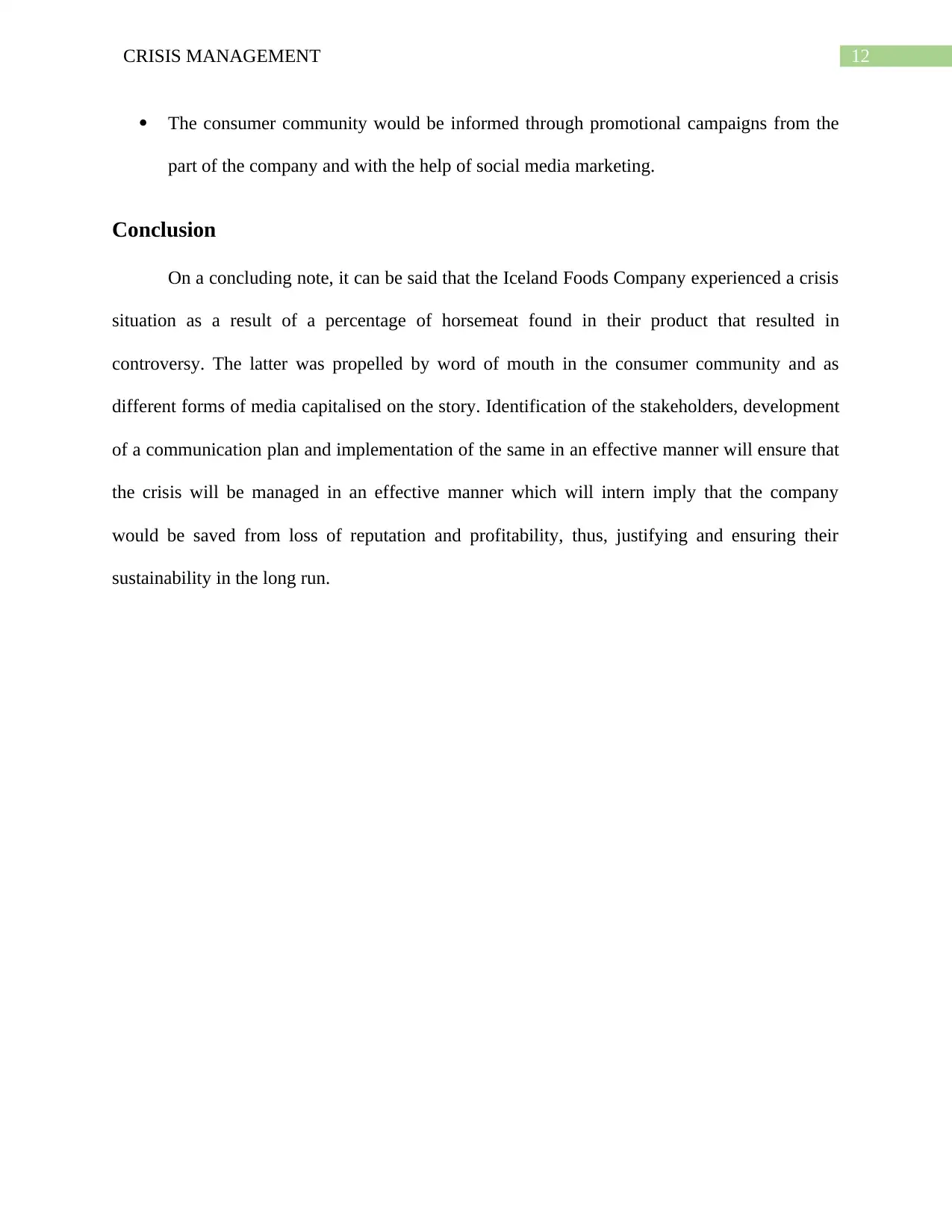
12CRISIS MANAGEMENT
The consumer community would be informed through promotional campaigns from the
part of the company and with the help of social media marketing.
Conclusion
On a concluding note, it can be said that the Iceland Foods Company experienced a crisis
situation as a result of a percentage of horsemeat found in their product that resulted in
controversy. The latter was propelled by word of mouth in the consumer community and as
different forms of media capitalised on the story. Identification of the stakeholders, development
of a communication plan and implementation of the same in an effective manner will ensure that
the crisis will be managed in an effective manner which will intern imply that the company
would be saved from loss of reputation and profitability, thus, justifying and ensuring their
sustainability in the long run.
The consumer community would be informed through promotional campaigns from the
part of the company and with the help of social media marketing.
Conclusion
On a concluding note, it can be said that the Iceland Foods Company experienced a crisis
situation as a result of a percentage of horsemeat found in their product that resulted in
controversy. The latter was propelled by word of mouth in the consumer community and as
different forms of media capitalised on the story. Identification of the stakeholders, development
of a communication plan and implementation of the same in an effective manner will ensure that
the crisis will be managed in an effective manner which will intern imply that the company
would be saved from loss of reputation and profitability, thus, justifying and ensuring their
sustainability in the long run.
Secure Best Marks with AI Grader
Need help grading? Try our AI Grader for instant feedback on your assignments.
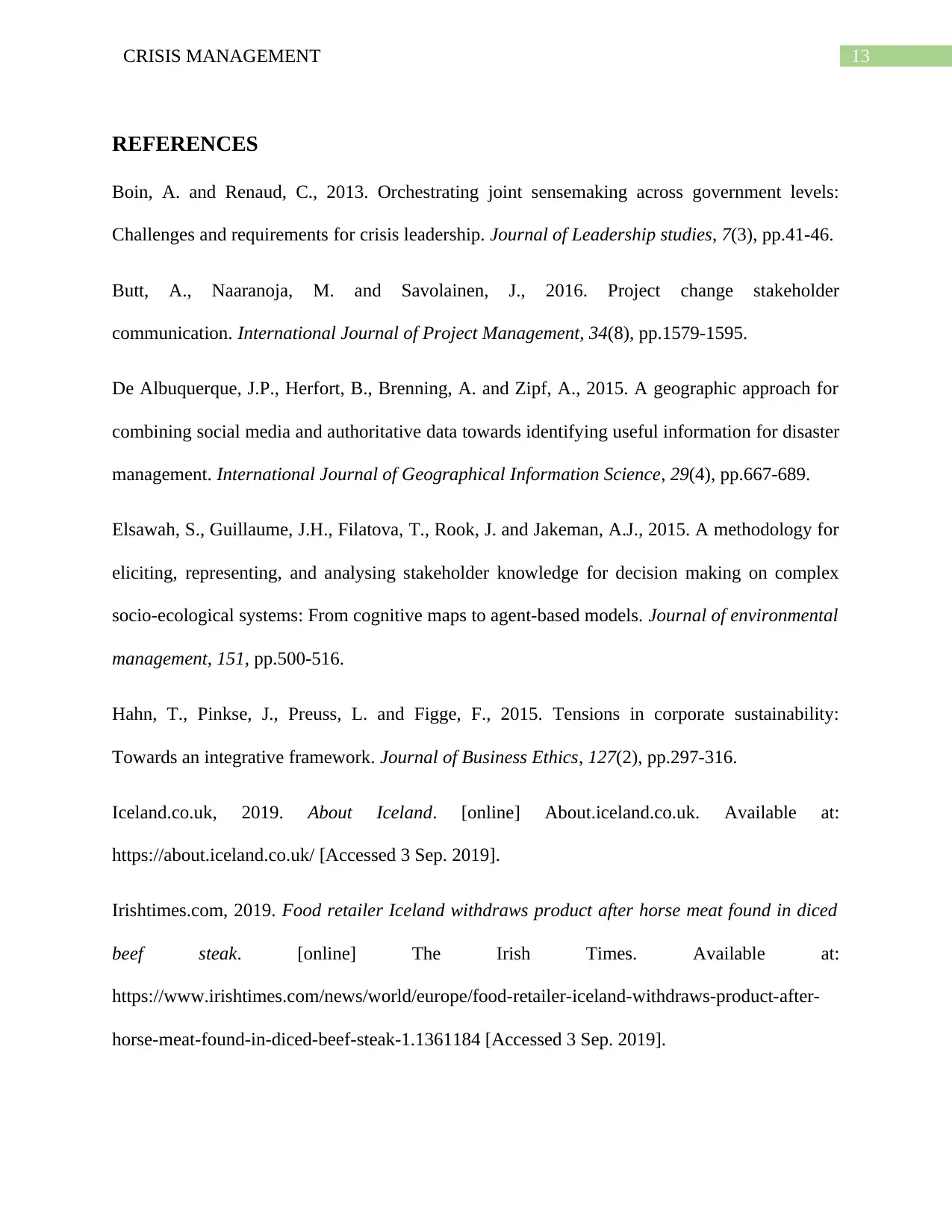
13CRISIS MANAGEMENT
REFERENCES
Boin, A. and Renaud, C., 2013. Orchestrating joint sensemaking across government levels:
Challenges and requirements for crisis leadership. Journal of Leadership studies, 7(3), pp.41-46.
Butt, A., Naaranoja, M. and Savolainen, J., 2016. Project change stakeholder
communication. International Journal of Project Management, 34(8), pp.1579-1595.
De Albuquerque, J.P., Herfort, B., Brenning, A. and Zipf, A., 2015. A geographic approach for
combining social media and authoritative data towards identifying useful information for disaster
management. International Journal of Geographical Information Science, 29(4), pp.667-689.
Elsawah, S., Guillaume, J.H., Filatova, T., Rook, J. and Jakeman, A.J., 2015. A methodology for
eliciting, representing, and analysing stakeholder knowledge for decision making on complex
socio-ecological systems: From cognitive maps to agent-based models. Journal of environmental
management, 151, pp.500-516.
Hahn, T., Pinkse, J., Preuss, L. and Figge, F., 2015. Tensions in corporate sustainability:
Towards an integrative framework. Journal of Business Ethics, 127(2), pp.297-316.
Iceland.co.uk, 2019. About Iceland. [online] About.iceland.co.uk. Available at:
https://about.iceland.co.uk/ [Accessed 3 Sep. 2019].
Irishtimes.com, 2019. Food retailer Iceland withdraws product after horse meat found in diced
beef steak. [online] The Irish Times. Available at:
https://www.irishtimes.com/news/world/europe/food-retailer-iceland-withdraws-product-after-
horse-meat-found-in-diced-beef-steak-1.1361184 [Accessed 3 Sep. 2019].
REFERENCES
Boin, A. and Renaud, C., 2013. Orchestrating joint sensemaking across government levels:
Challenges and requirements for crisis leadership. Journal of Leadership studies, 7(3), pp.41-46.
Butt, A., Naaranoja, M. and Savolainen, J., 2016. Project change stakeholder
communication. International Journal of Project Management, 34(8), pp.1579-1595.
De Albuquerque, J.P., Herfort, B., Brenning, A. and Zipf, A., 2015. A geographic approach for
combining social media and authoritative data towards identifying useful information for disaster
management. International Journal of Geographical Information Science, 29(4), pp.667-689.
Elsawah, S., Guillaume, J.H., Filatova, T., Rook, J. and Jakeman, A.J., 2015. A methodology for
eliciting, representing, and analysing stakeholder knowledge for decision making on complex
socio-ecological systems: From cognitive maps to agent-based models. Journal of environmental
management, 151, pp.500-516.
Hahn, T., Pinkse, J., Preuss, L. and Figge, F., 2015. Tensions in corporate sustainability:
Towards an integrative framework. Journal of Business Ethics, 127(2), pp.297-316.
Iceland.co.uk, 2019. About Iceland. [online] About.iceland.co.uk. Available at:
https://about.iceland.co.uk/ [Accessed 3 Sep. 2019].
Irishtimes.com, 2019. Food retailer Iceland withdraws product after horse meat found in diced
beef steak. [online] The Irish Times. Available at:
https://www.irishtimes.com/news/world/europe/food-retailer-iceland-withdraws-product-after-
horse-meat-found-in-diced-beef-steak-1.1361184 [Accessed 3 Sep. 2019].
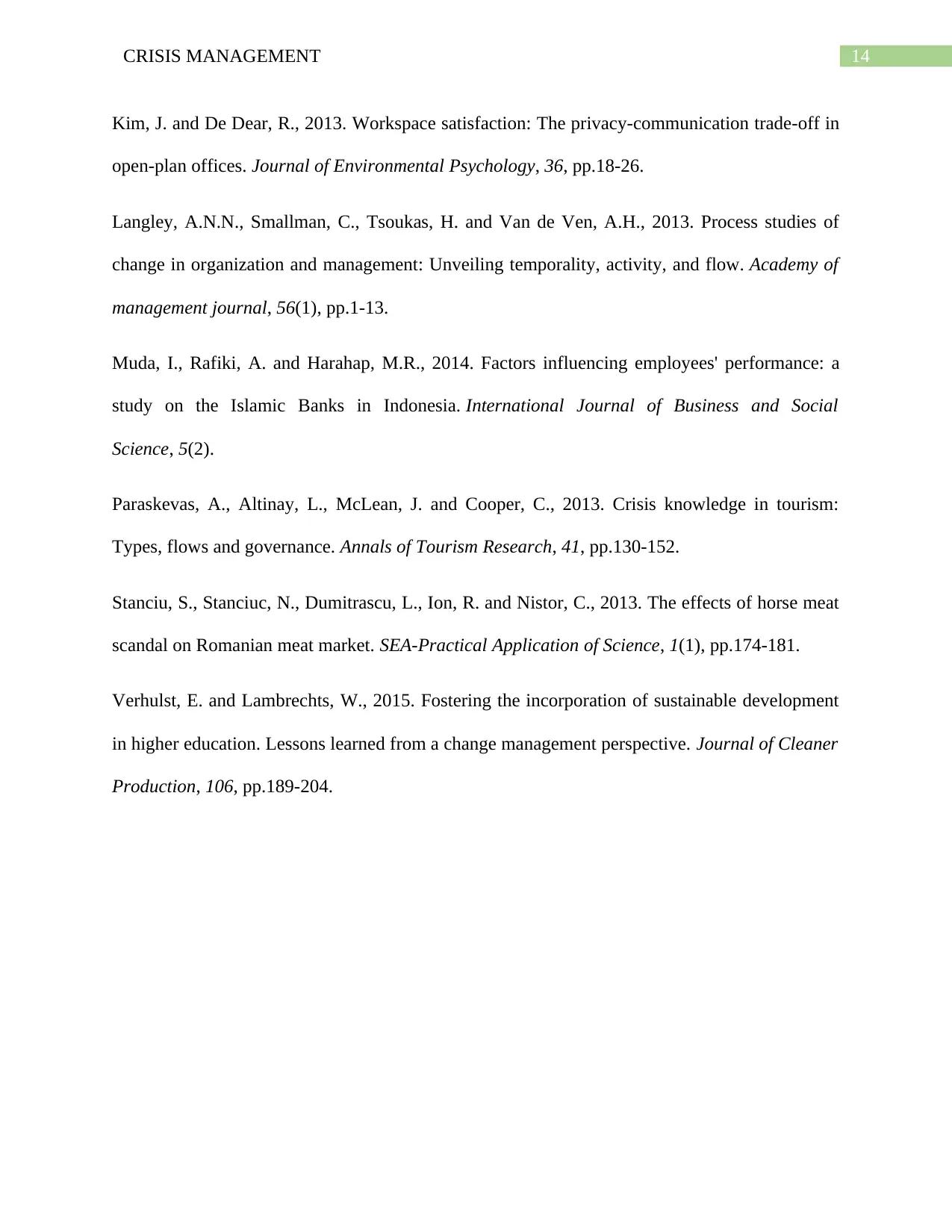
14CRISIS MANAGEMENT
Kim, J. and De Dear, R., 2013. Workspace satisfaction: The privacy-communication trade-off in
open-plan offices. Journal of Environmental Psychology, 36, pp.18-26.
Langley, A.N.N., Smallman, C., Tsoukas, H. and Van de Ven, A.H., 2013. Process studies of
change in organization and management: Unveiling temporality, activity, and flow. Academy of
management journal, 56(1), pp.1-13.
Muda, I., Rafiki, A. and Harahap, M.R., 2014. Factors influencing employees' performance: a
study on the Islamic Banks in Indonesia. International Journal of Business and Social
Science, 5(2).
Paraskevas, A., Altinay, L., McLean, J. and Cooper, C., 2013. Crisis knowledge in tourism:
Types, flows and governance. Annals of Tourism Research, 41, pp.130-152.
Stanciu, S., Stanciuc, N., Dumitrascu, L., Ion, R. and Nistor, C., 2013. The effects of horse meat
scandal on Romanian meat market. SEA-Practical Application of Science, 1(1), pp.174-181.
Verhulst, E. and Lambrechts, W., 2015. Fostering the incorporation of sustainable development
in higher education. Lessons learned from a change management perspective. Journal of Cleaner
Production, 106, pp.189-204.
Kim, J. and De Dear, R., 2013. Workspace satisfaction: The privacy-communication trade-off in
open-plan offices. Journal of Environmental Psychology, 36, pp.18-26.
Langley, A.N.N., Smallman, C., Tsoukas, H. and Van de Ven, A.H., 2013. Process studies of
change in organization and management: Unveiling temporality, activity, and flow. Academy of
management journal, 56(1), pp.1-13.
Muda, I., Rafiki, A. and Harahap, M.R., 2014. Factors influencing employees' performance: a
study on the Islamic Banks in Indonesia. International Journal of Business and Social
Science, 5(2).
Paraskevas, A., Altinay, L., McLean, J. and Cooper, C., 2013. Crisis knowledge in tourism:
Types, flows and governance. Annals of Tourism Research, 41, pp.130-152.
Stanciu, S., Stanciuc, N., Dumitrascu, L., Ion, R. and Nistor, C., 2013. The effects of horse meat
scandal on Romanian meat market. SEA-Practical Application of Science, 1(1), pp.174-181.
Verhulst, E. and Lambrechts, W., 2015. Fostering the incorporation of sustainable development
in higher education. Lessons learned from a change management perspective. Journal of Cleaner
Production, 106, pp.189-204.
1 out of 15
![[object Object]](/_next/static/media/star-bottom.7253800d.svg)





